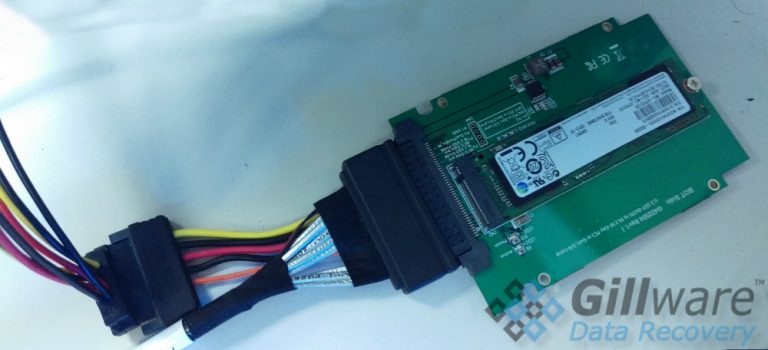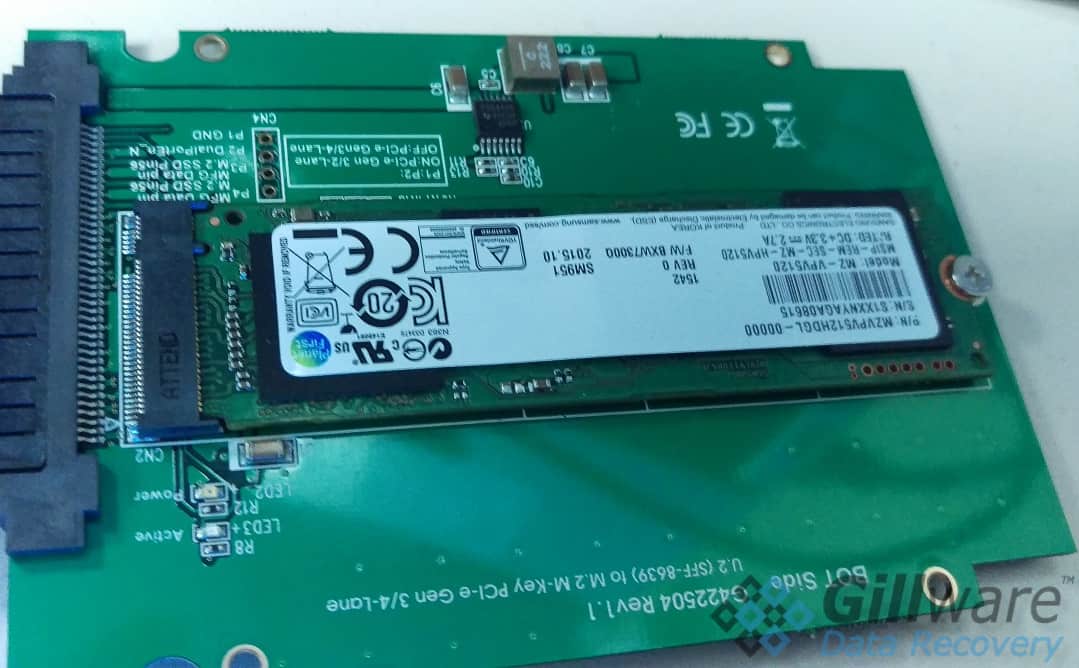Samsung SSD Recovery Case Study: Form Factor Fricassee
In this Samsung SSD recovery case, our client came to us with the solid state drive from their notebook PC. They were having a problem booting into Windows. BIOS could detect the presence of the drive, but would fail to boot from it. The client removed the SSD from their computer and stuck it in an adapter to try and read it on another computer. The other computer detected the device, but only intermittently. When the client tried to copy data off of the Samsung SSD (the few times it appeared) it would disappear shortly thereafter.
Samsung SSD Recovery Case Study: Form Factor Fricassee
Drive Model: Samsung MZVPV512HDGL-00000
Drive Capacity: 512 GB
Operating System: Windows
Situation: Device detects only intermittently, and disappears from the O/S a few seconds after trying to read from it
Type of Data Recovered: Documents from specific folders on the desktop
Binary Read: 55.4%
Gillware Data Recovery Case Rating: 9+
Gillware’s resident flash memory data recovery specialist Greg Andrezejewski has pioneered many techniques for recovering data from failed flash devices, and he would be tackling this Samsung SSD recovery case. Thanks in no small part to Greg’s expertise, Gillware is a leader in solid state device data recovery. If any data recovery company could recover data from this failed solid state drive, it would be us.
Form Factor Fricassee
In one of ancient Greek playwright Aristophanes’ plays, the characters mention a dish called “Lopadotemachoselachogaleokranioleipsanodrimhypotrimmatosilphioparaomelitokatakechymenokichlepikossyphophattoperisteralektryonoptekephalliokigklopeleiolagoiosiraiobaphetraganopterygon”, a type of fricassee consisting of all manner of fish and fowl. With 171 letters, it holds the dubious distinction of being the longest word to ever appear in a work of literature in all of human history. (It’s also a very difficult dish to discuss on Twitter.) This dish has about dozen different species of bird and fish inside it, which isn’t too far off from how many form factors and interface standards of SSD there are out there.
The hard drives you’re accustomed to, for the most part, connect to your computer using some type of ATA connection. Modern hard disk drives use the Serial ATA interface. Older hard drives make use of the Parallel ATA, also known as IDE, interface. Even the hard disk drives in your portable enclosures still “speak” through SATA, although they have some type of dongle or expanded PCB adapting them to USB standards.
Some SSDs speak SATA as well. But that’s a problem. In fact, it’s two problems. SATA was designed to work with spinning disks—which, compared to SSDs, are painfully slow. The other problem is that the SATA interface takes up a lot of space. When manufacturers started developing ultra-thin notebook laptops, they noticed this problem. They needed a new language for SSDs to speak with their host controllers—not only for SSD efficiency, but so they could fit the things in their computers.
The Many Languages of SSD Interfaces
Manufacturers came up with a lot of solutions. One such solution: the M.2 interface. This was the connection used by the client’s SSD. This interface actually comes in several flavors. You can have a drive with a PCIe M.2 connection, a SATA M.2 connection, or a NVMe M.2 connection, for example. These variations of M.2 all look a little different. Most have to be plugged into differently-shaped slots. What fun!
SATA M.2 isn’t all that special. It’s got the itty bitty M.2 form factor, but still uses SATA interface protocols to talk to the SSD. PCIe and NVMe M.2 drives, however, have an interface custom designed for lightning-fast flash memory. The client’s drive in this Samsung SSD recovery case used the PCI interface. This solid state drive’s form factor was going to make this data recovery case a bit trickier for our data recovery experts.
Samsung SSD Recovery
Like hard disk drives, SSDs have firmware of their own to deal with the flow of data in and out of the device. SSD firmware is a complicated creature. Since it can’t be easily repaired without wiping all of the data on the drive, it’s designed to be pretty resilient. But it still bugs out on occasion. And when it does, you have a dead (or, in our client’s case, only mostly dead) SSD on your hands.

SSD firmware can develop many similar glitches to hard drive firmware. In particular, one neat thing SSD and HDD firmware can do is function perfectly until it hits an error it doesn’t know what to do with, at which point it freaks out and crashes, leaving your device to hang infinitely until you cycle the power to it (in other words, turn it off and on again). This is what was happening with the client’s Samsung SSD.
To deal with this issue in hard disk drives through a SATA bus controller, our engineers can cycle power to the drive every time its firmware flips out, imaging the drive a couple hundred or thousand sectors at a time. Unfortunately, when it comes to PCI, it’s not so easy to cycle power to the device—at least not through a PCI bus controller.
Our SSD recovery specialist Greg had a plan, though. His plan for this Samsung SSD recovery case involved, unsurprisingly, yet another type of SSD interface.
U.2? And I thought I was the only one!
The U.2 interface (not to be confused with the Irish rock band U2) is yet another way for SSDs to communicate with their hosts. U.2 solid state drives have 2.5-inch form factors, just like SATA SSDs, but the U.2 connection bears more resemblance to M.2 than SATA. With more lanes, it can transmit more information at once, resulting in faster data transfer speeds than SATA drives.
There exist U.2 adapters for M.2 SSDs, which basically include a bridging PCB with an M.2 port for the SSD to plug in on one side and a U.2 interface to plug into a U.2 slot on the other. Manufacturers designed these adapters for people who want to be able to use M.2 SSDs in devices like desktop computers and servers that could better support 2.5-inch devices. And for Greg, the U.2 adapter was going to crack this Samsung SSD recovery case wide open.
While Greg couldn’t easily cycle power to the client’s M.2 SSD itself every time it encountered an error that made its firmware wet the bed, he could cycle power to the U.2 adapter. With some tweaks to the hardware and software used by our data recovery platform HOMBRE (designed and maintained by Greg), Greg could automatically cycle power to the client’s M.2 SSD when needed. By cycling power and imaging the client’s SSD in the time between resets, Greg could recover the client’s data inch by inch. After imaging 55.4% of their drive, we had successfully recovered the vast majority of the client’s data. This Samsung SSD recovery case ended up a complete success.

